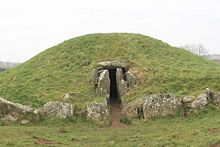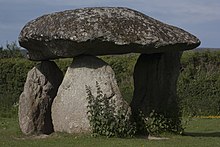The Neolithic spanned from around 4000BC to 2,500BC. It was the final part of the Stone Age – the ‘New Stone Age – and we see the peoples of the Neolithic Revolution adopting agriculture and settling down in one place. To make room for new farmland, mass deforestation took place while new types of stone tools began to be produced.
The Neolithic also saw the construction of monuments in the landscape. The earliest of these are chambered tombs, to later be replaced by stone circles – the greatest of which are at Stonehenge and Avebury. These megaliths seem to be linked with the new ways that people thought, in religion, ritual and how society was ordered.
Neolithic peoples weren’t literate so we have to rely on what they left behind in the landscape. The other issue is that the entire population of Britain in the early Neolithic may have been only around 100,000 people. Not much is left, particularly in Torbay which has largely been built on. However, there is one surviving Torbay megalith – the Neolithic Chambered Tomb, or Passage Grave, at Broadsands.
Dated to 3768-3641 BC this stone mound megalithic chamber had a single entrance passage 3.8 metres long and 1.2 metres wide within a circular cairn 12 metres in diameter at construction. The chamber is 3.35 metres by 2.1 metres and has a height of 1.6 metres. The chamber was constructed of eleven local limestone upright stones with an infill of dry stone walling. Seven of these stones remain while one of the capstones lies almost upright.
Celli Ddu on Anglesea- similar to what the Broadsands Tomb would have looked like
Discovered in 1956 by Guy Belleville, a local archaeologist, the tomb was excavated by C Ralegh Radford in 1958. Archaeologists found three first inhumations of two adults and one infant alongside Neolithic pottery – an adult male aged at least forty, a young adult male who was at least 5ft 6ins tall, and the infant. There may have been more as the remains had later been cleared to the sides of the chamber and trodden into the floor. It was when two human thighbones still embedded in soil were dated that we found that the inhumations took place between 3768 and 3641 BC.
It appeared as if several ritual fires had been lit before a new pavement was put in position, possibly a ritual cleansing prior to reusing the chamber. Then there was a later inhumation of a young male below the age of twenty alongside later Neolithic pottery.
Oddly, evidence from stable isotope analysis showed that the occupants of the tomb had a diet almost wholly based on land based food. Very little fish was being eaten, despite these folk living so close to the sea – Guy Belleville also found worked flints, arrowheads and parts of polished flint axes about half a mile from the tomb.
Another local megalith: Spinsters’ Rock near Drewsteignton
There appears to be no other definite examples of a Passage Tomb in the southwest of England and they are unusual in Britain. However, they are common in Portugal and Brittany, suggesting some kind of link with the continent.
During the Medieval period the tomb was incorporated into a hedge bank marking the parish boundary between Paignton and Churston Ferrers. Accordingly, it’s quite difficult to spot. However, some stones and items from the tomb are in Torquay Museum.
And perhaps we shouldn’t be calling it a tomb at all. While our megalith did contain human remains, many others in use for 3 to 4,000 years contained no bones at all. In these, remains were inserted hundreds of years after the megaliths were constructed, after their original purpose was apparently abandoned. It was only later that they were used as crypts.
So are we the decedents of those original Neolithic builders? It doesn’t appear as though most of us are. The Neolithic population of Britain was almost completely replaced by newcomers about 4,500 years ago. Recent DNA studies extracted from 400 ancient remains across Europe show that the culture that brought later Bronze Age technology to Britain was connected to a migration by a people from the Beaker culture which spread across Europe and can be tracked through its distinctive pottery. The Beaker people replaced 90% of the British gene pool in a few hundred years. And they would have looked differently to our tomb builders. They replaced our Neolithic Torbay folk, who had olive-brown skin, dark hair and brown eyes. In comparison, the Beaker folk had lighter skin, blue eyes and blonde hair.
Thanks go to Tom Joliffe for his image of the Broadsands tomb:
cc-by-sa/2.0 – © Tom Jolliffe – geograph.org.uk/p/2061501











